Ep. 30: An Invitation From a Crab, by panpanya
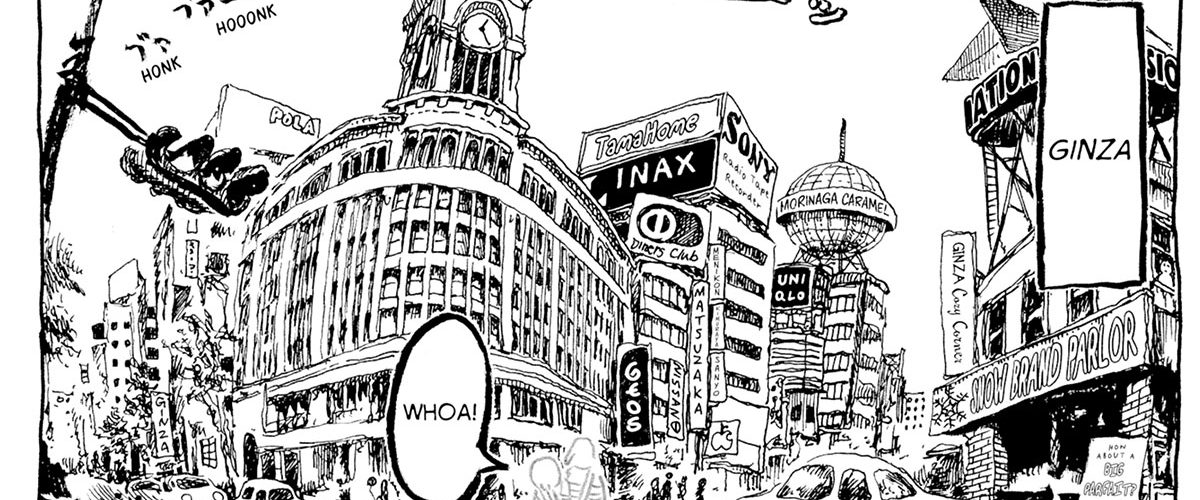
A doozy of an episode! We talk about Panpanya’s An Invitation from a Crab, our first ‘alternative’ manga on the podcast. Then Christopher interviews Ko Ransom, the translator for this comic in a new “Mangasplaining: Listen to Me!” segment. Finally, we get a question about overwork in the manga industry that goes to some very personal places.
In this episode:
00:00 An Invitation from a Crab
41:23 The Break
42:00 Mangasplaining: Listen To Me! Interview with Translator Ko Ransom
1:04:20 The Second Break
1:04:30 Q&A: Is creating manga a masochistic profession?
Powered by RedCircle
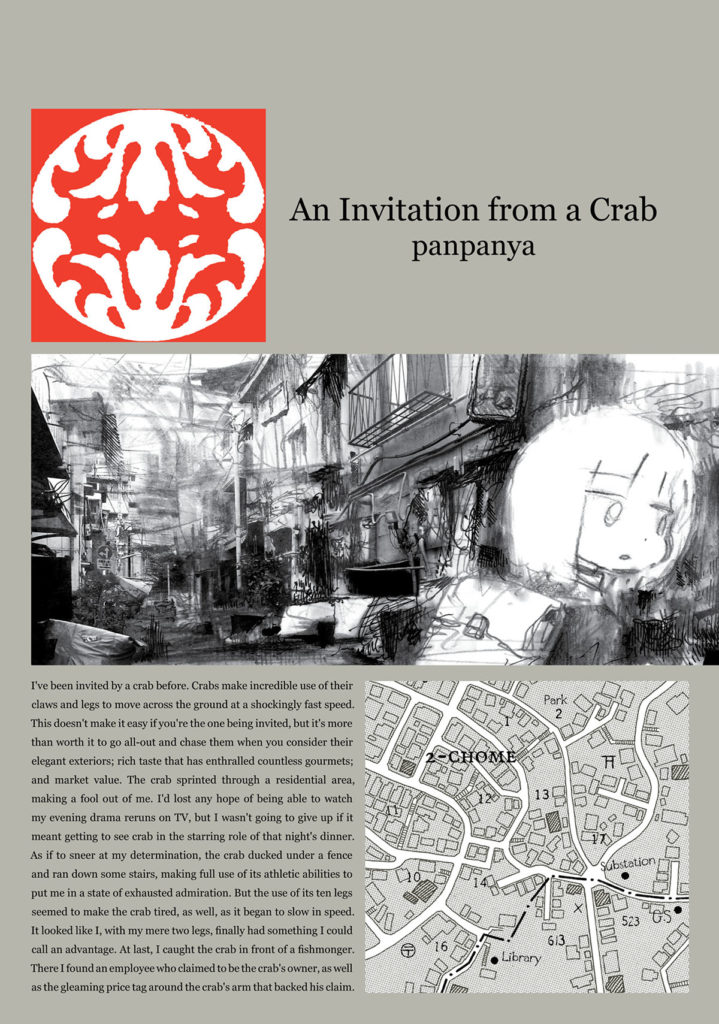
An Invitation from a Crab
By Panpanya
Translated by Ko Ransom
Lettering and production: Nicole Dochych
Digital production: Taneli Vatanen
Published by Denpa Publishing (Print and digital)
Show notes by Christopher Butcher, edited by Deb Aoki. Audio episode edited by David Brothers.
00:00 Before we start: Just want to mention that the word “doujinshi” (Doh-jin-she) generally just means “amateur publication” in Japan. For this episode, we’re specifically referring to manga doujinshi, or independently-published manga. These are generally A4 size (sort of like 8.5” x 11”), and generally 24-32 pages, with a cardstock cover… but there’s a tremendous variety of doujinshi available about all kinds of subjects (it’s not just manga!) in all kinds of sizes and formats.
This particular book has a lot of ‘twists’ or ‘reveals in the various short stories’, and we do get into them. So if you’re spoiler-sensitive, well, SPOILERS for sure on this one. I’ll try not to ‘ruin’ any surprises more than we already have by including images/pages where I can avoid it. Still, we’re sharing a lot of images for this episode.
Speaking of which, here are some articles that I read to prep for this episode.
- Joe McCulloch reviews An Invitation from a Crab – http://www.tcj.com/reviews/an-invitation-from-a-crab/
- Panpanya Interview, fan-translation – https://laikagohome.tumblr.com/post/86406074176/ashizuri-suizokukan-panpanya-special-interview
- And of course Panpanya’s website – http://www.panpanya.com/
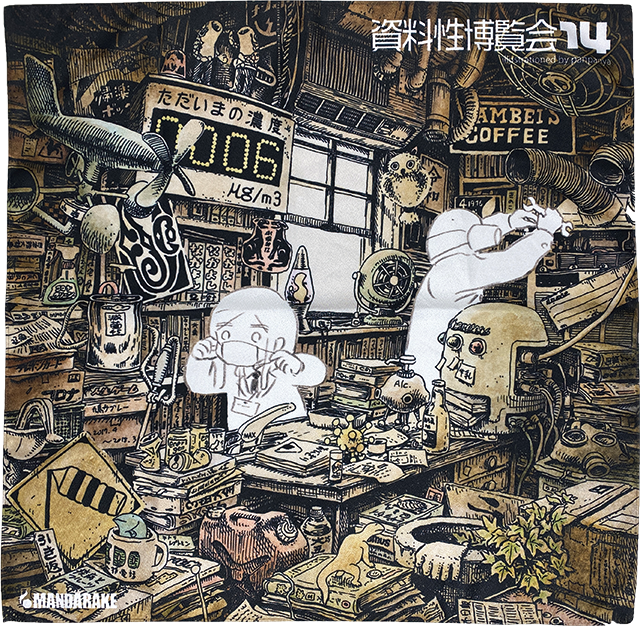
02:08 It’s true! The independent publishing scene is deeply bolstered by a mass of independent printers! Check out this page on the website for the doujinshi event “Comitia”, which lists all the publishers that will print your comics and ship them directly to the venue for you. I recommend using Google Chrome for the auto-translate feature: https://www.comitia.co.jp/html/print_fair.html
Spoilers: There are nearly 50 printers listed on that page.
2:44 I should note that while An Invitation From a Crab is Panpanya’s second Japanese book, it’s their first to be translated into English. You can start here, no problem. 🙂
4:30 If you listened earlier and jumped to the interview with translator Ko Ransom, you’ll see that Yoshiharu Tsuge is a huge influence on Panpanya’s work. Good eye, Deb!
5:45 “The character with a bulb on its head.” I probably should have mentioned this on the podcast, but Panpanya doesn’t really draw most characters as human except for their self-insert character. Notable exceptions are the one short where their protagonist is in school with actual other schoolchildren (how old is this character anyway?). The various characters of Panpanya’s world are more often depicted as yokai, as animals, ghosts, and as non-human bulb-headed beings. I think that sort of reinforces my idea of Panpanya seeing themselves as ‘distant’ or ‘apart from’ the rest of the world in the book.
6:30 So Hayao Miyazaki’s film Spirited Away is about a girl who accidentally travels to a world just around the corner from our own, filled with spirits, magic, danger, and like, metaphors. Anyway, everything is simultaneously familiar and filled with a sense of unknowing and dread. If you’ve seen it hopefully you get what I mean. That feeling is infused throughout An Invitation From a Crab. If you haven’t seen Spirited Away, you should, it’s on Netflix.
[Deb:] In some parts of the world, Spirited Away can be streamed on Netflix. USA is not one of them, though apparently since Chris could watch it, it IS available via Netflix Canada. It is available to US viewers via HBO MAX, so anyway… YMMV.
But in the interim, this Japanese trailer for the film, all from the film’s first 15 minutes or so, and it should give you a sense of the danger and dread.
10:45 This is what I’m talking about here. Panpanya draws themselves impermanent, but existing in a very detailed and permanent landscapes and cityscapes. Even when Panpanya touches the crab, it becomes less defined, less ‘real.’
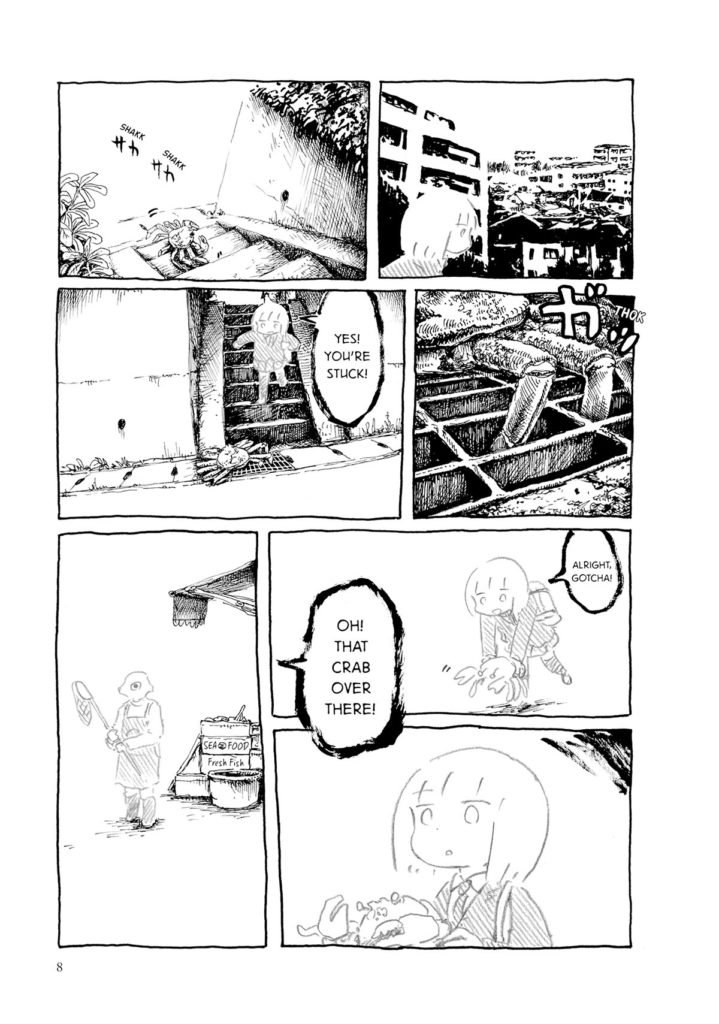
15:30 Chip mentions getting the feel for a place, without necessarily being super accurate about it. I think this shot of Ginza, which is a real place in Tokyo, is a good example of that. Some of these buildings are real, and some of them are made up, creating a sort of unreality. I end up talking about this a bit at 19:00.
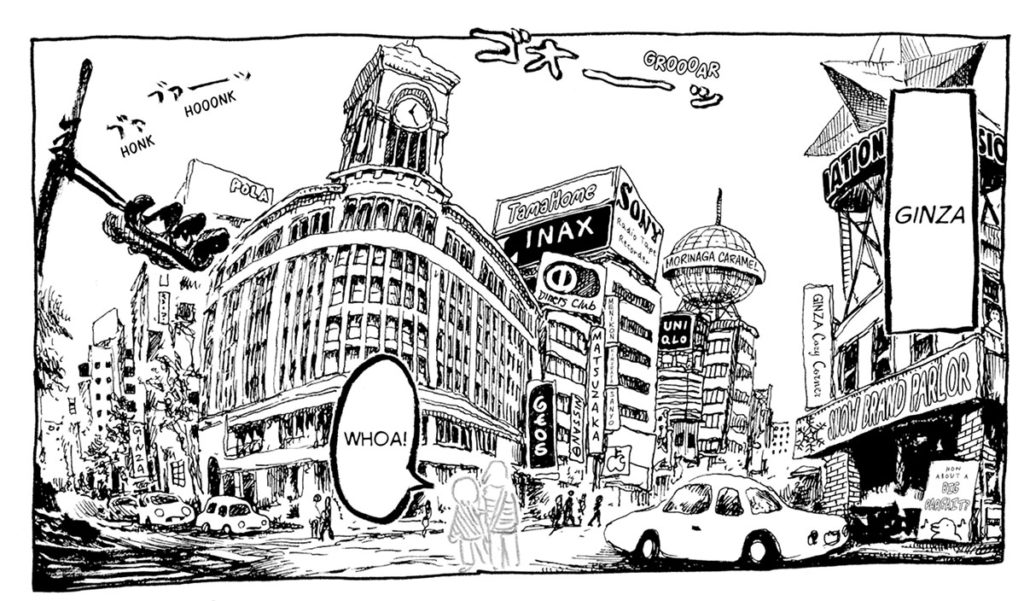
15:50 David references Page 192, and this little residential streetscape, which absolutely looks like a sketchbook drawing.
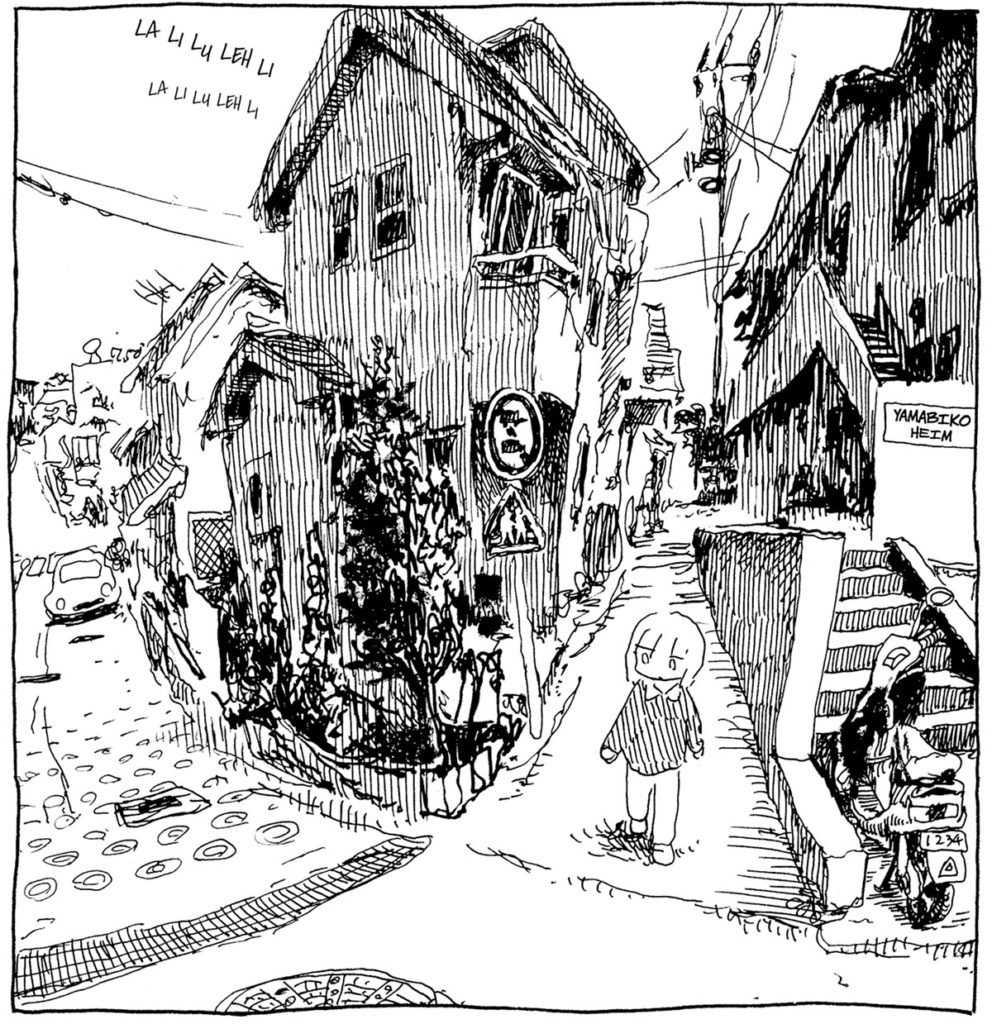
16:20 The shot from below, where the character is walking through transit gates, that Chip mentions, from page 83.
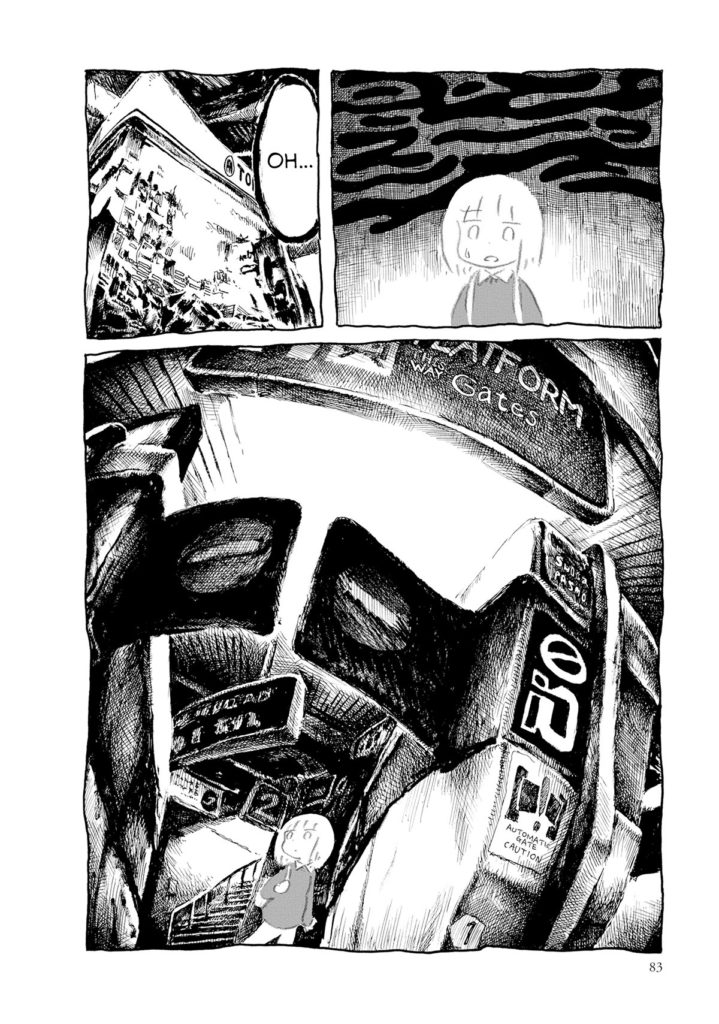
18:40 The Dolphin Calculator. This is probably the funniest, most ‘Adult Swim’ story in the entire collection. Actually, I think that David made a great observation there, and these stories would probably kill it as an adult cartoon.
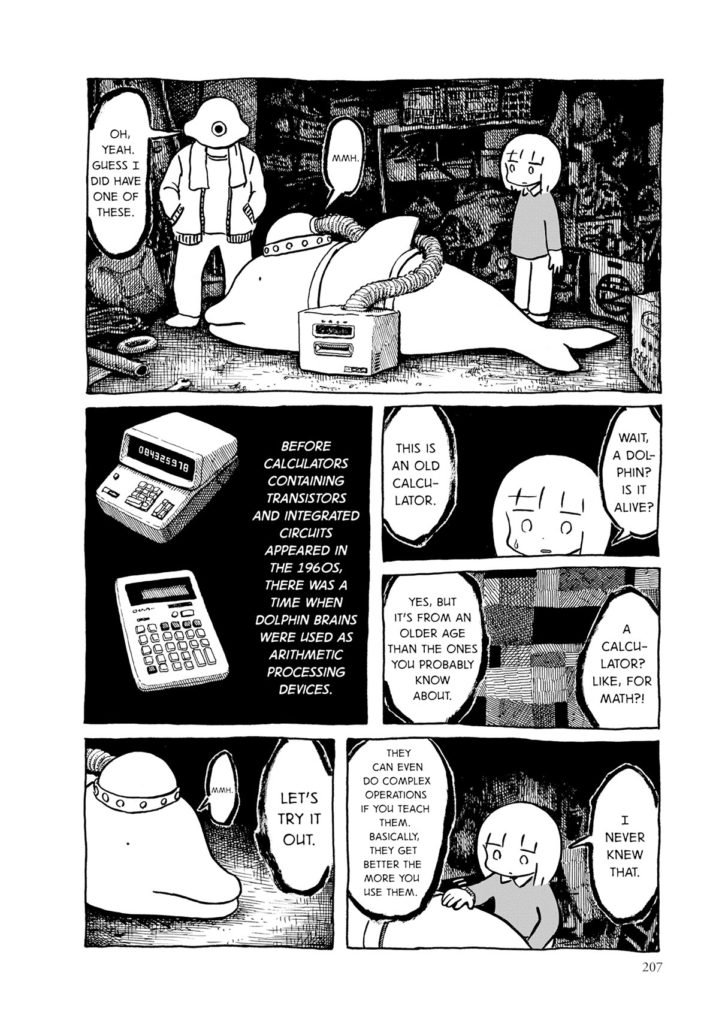
20:37 Deb references page 89, and it’s one of my favourite drawings in the book. So spooky.
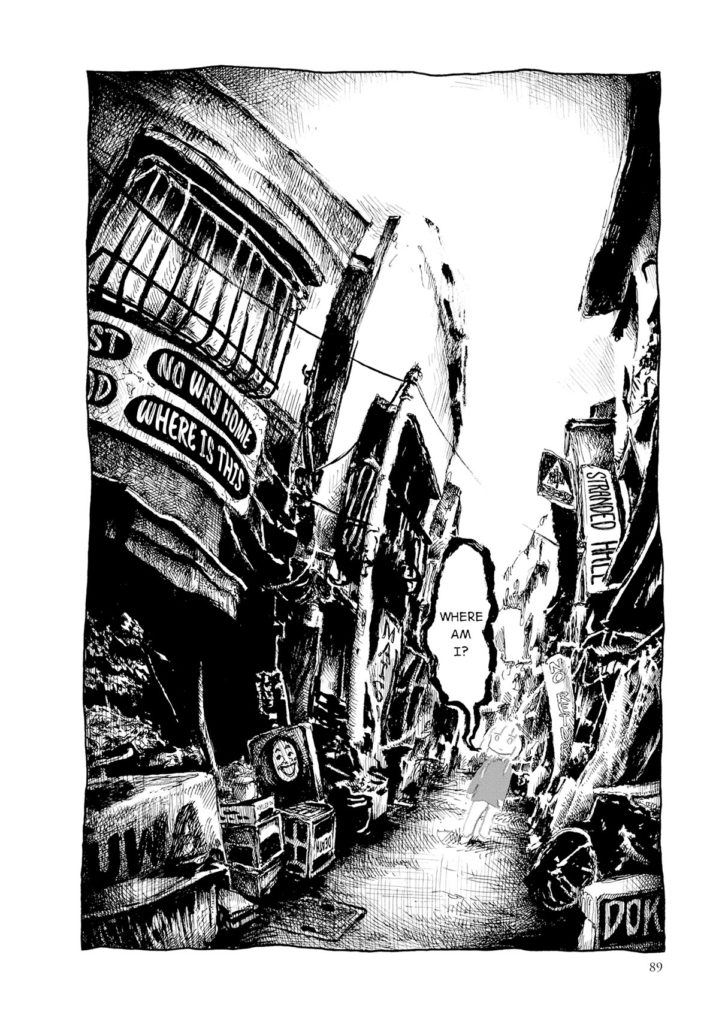
20:46 The Dog That’s Going For A Walk By Itself is actually from the story “A Restless Day” beginning on page 162. It’s a neat story, where a series of very small, strange occurrences (dog aside) happen and the lead character is convinced these are bad omens that hint that they’re gonna have a bad day. It’s interesting.
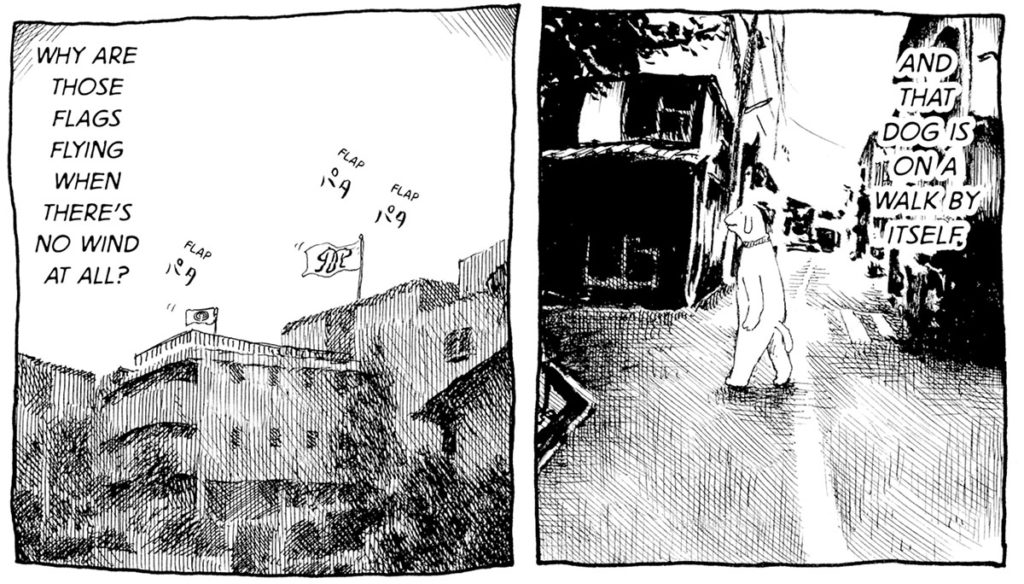
And here’s the pencils, tones, and heavy inks from the ‘Wandering, Wondering’ story.
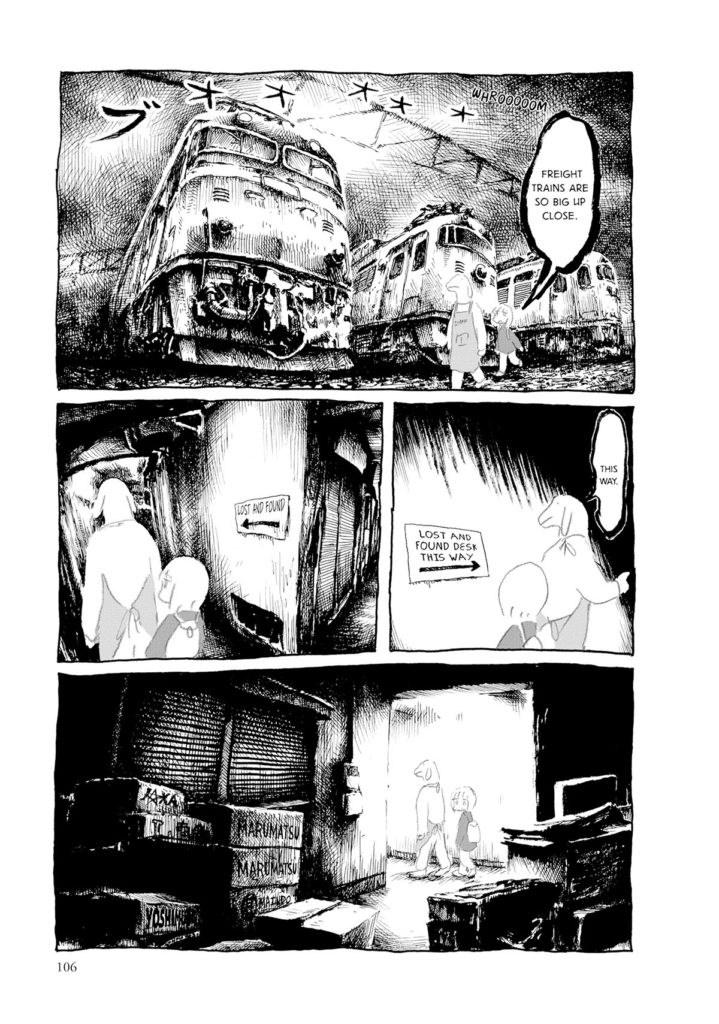
And then to Page 69, where the Pineapple Man is drawn in pencil (like Panpanya and their friend) when he’s being friendly, but then on the bottom of page 69 when he’s being serious he becomes ink and part of the background again.
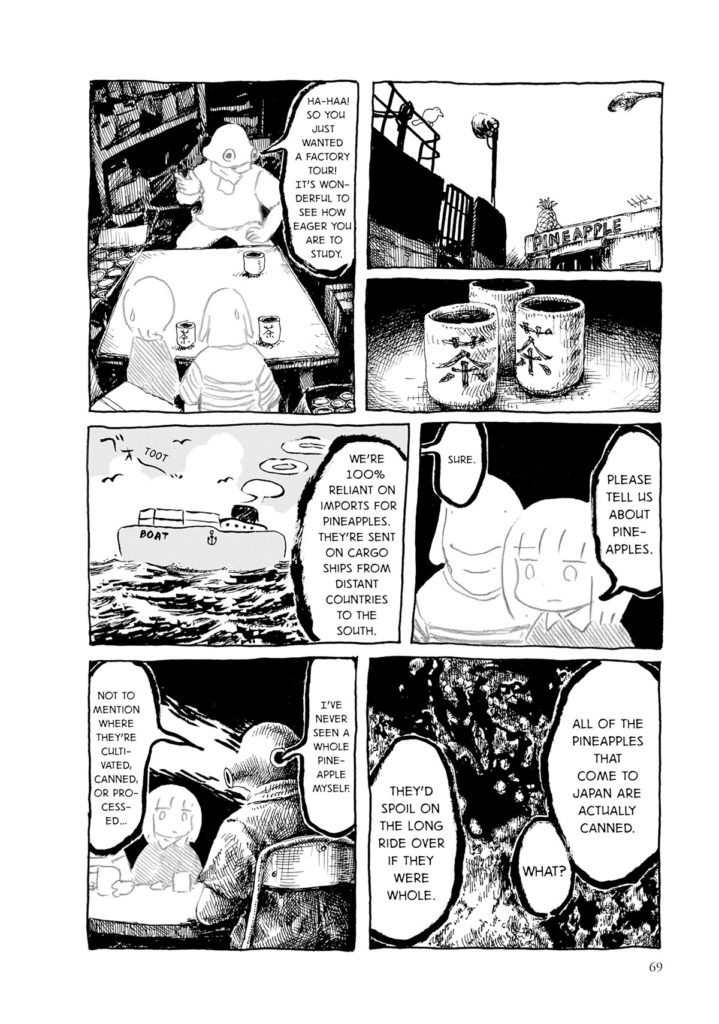
I think this is really driven home at the bottom of page 165, where Panpanya is touched by a ‘realistic’ hand and is shocked. GREAT lettering on “EEK!” by the way, wow. 🙂 But then on page 166, the person who tapped the character is a friend, is safe, and is pencil lines again.
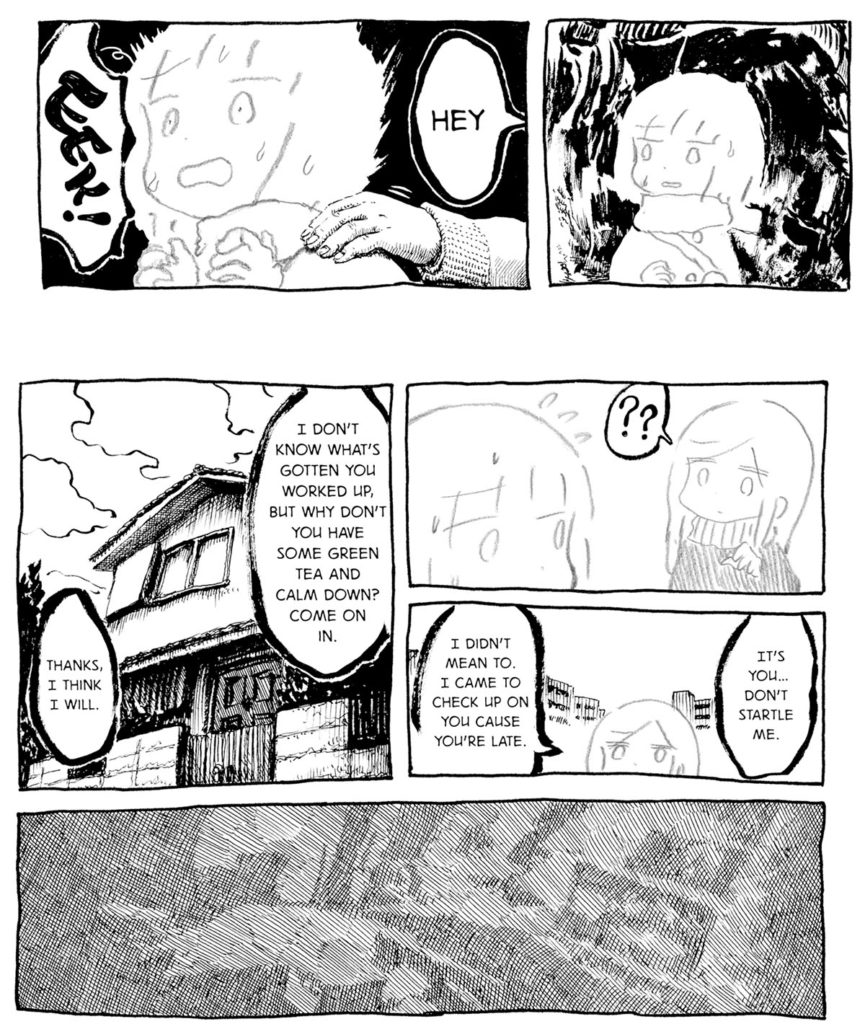
27:00 I think we all really love the Dolphin Calculator story. There’s so many good jokes in this one, we’ll just include this page. Go buy the book for the rest of the jokes. 🙂
28:30 Showa Era decrepitude. Some of my favourite places in Tokyo, and really throughout the country, are the bits where urban decay starts to rust through and you see the layers of lives that have been lived before you got there. There are real, real moments of that in this book. Ko talks about it a little bit in the interview. Check it out!
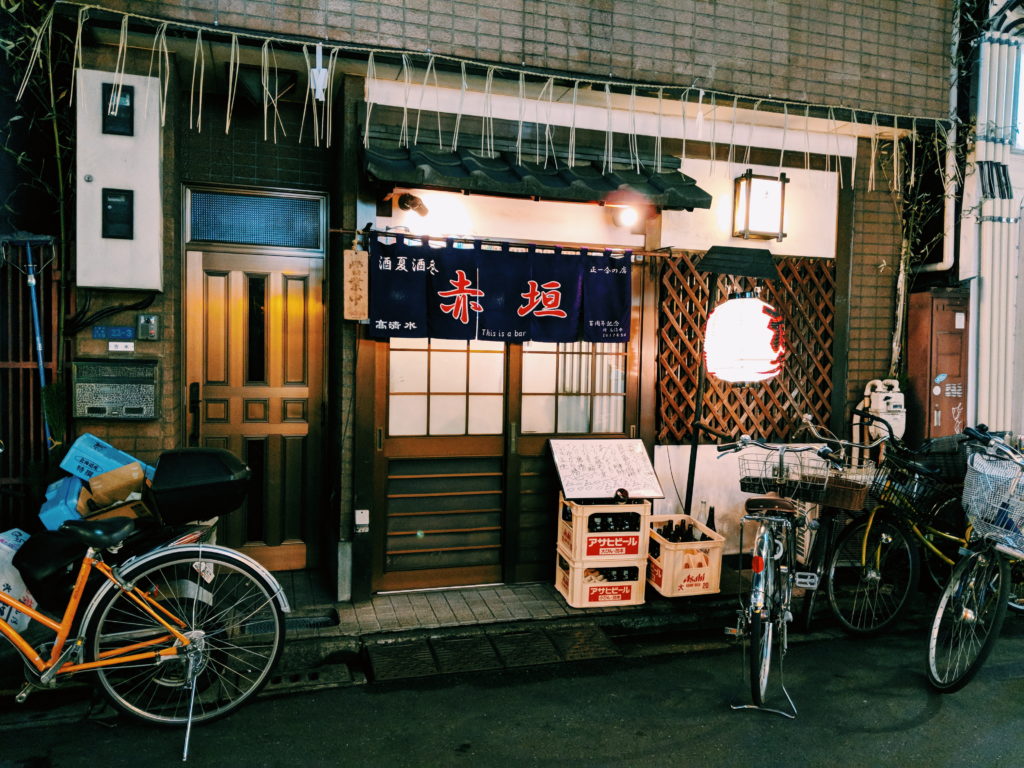
31:30 Hakusensha is a major manga publisher in Japan. Best known for their magazines Hana to Yume (Flowers & Dreams) and Young Animal, which published the series’ Fruits Basket and Berserk respectively. They also publish the online magazine Rakuen, which is where Panpanya’s work appears.
(We can play the Sesame Street game ‘one of these things is not like the others’ scrolling down that page. 😉
34:10 Guyabano Holiday is the next English-language release from Panpanya, coming from Denpa Books in December. Pre-order your copy today, at your local comic shop (it’s in the October Previews) or using ISBN 9781634429641
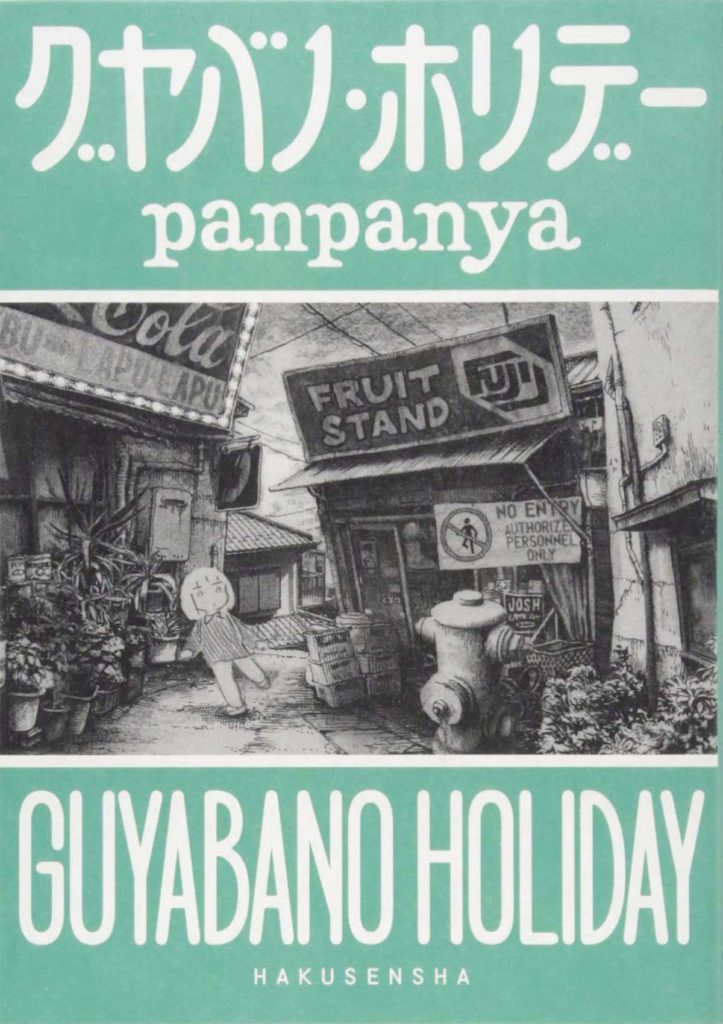
38:00 David mentions City by Arawi, again. MAYBE he’ll recommend it and we’ll read it on a future episode…! 😉
39:10 You can find Yoshiharu Tsuge’s The Man Without Talent at the New York Review of Books’ website. https://www.nyrb.com/collections/new-york-review-comics/products/the-man-without-talent?variant=29168539107380
You can find the rest of Yoshiharu Tsuge’s English-language output at Drawn & Quarterly’s website. https://drawnandquarterly.com/author/yoshiharu-tsuge
It’s also worth noting (as I’ve seen it confused previously) that Yoshiharu’s brother, Tadao Tsuge, has also had a few books published in English, also from New York Review of Books and Drawn & Quarterly. He also has a new book coming from small publisher Black Hook Press later this year. You can check out one of his short stories, an excerpt from Slum Wolf, for free at the Granta website. https://granta.com/slum-wolf/, and you can pre-order his newest, Tale of the Beast, from the Black Hook website.
40:15 So I think it’s safe to say I liked a lot of imagery in this book.
This page with the carp streamers:
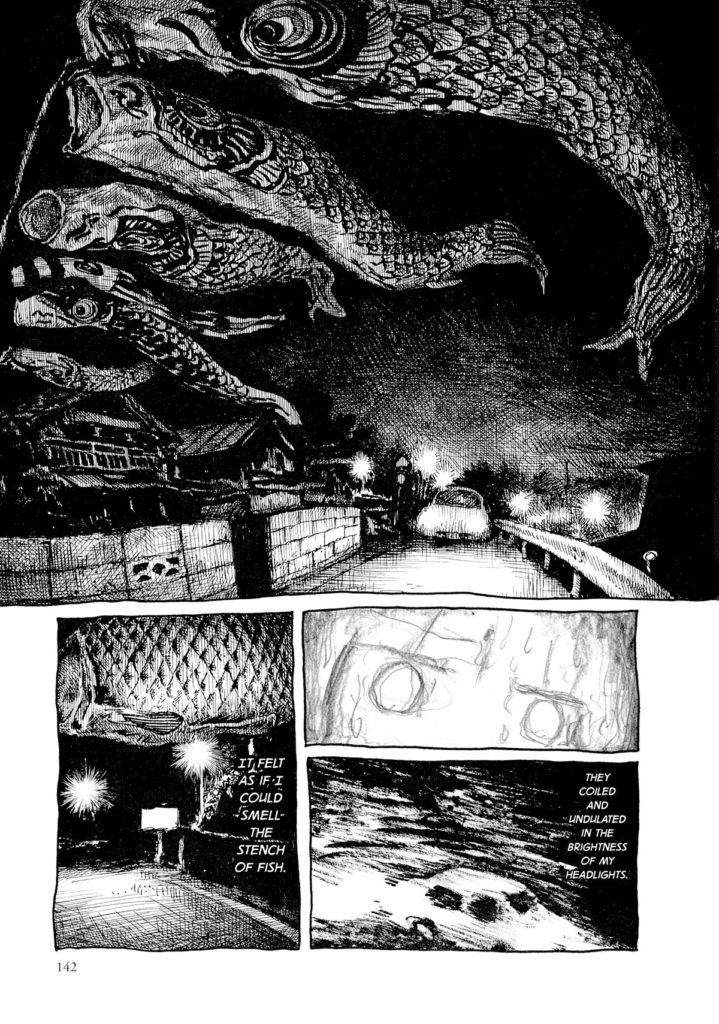
This map, which they actually translated, lettered, and redrew:
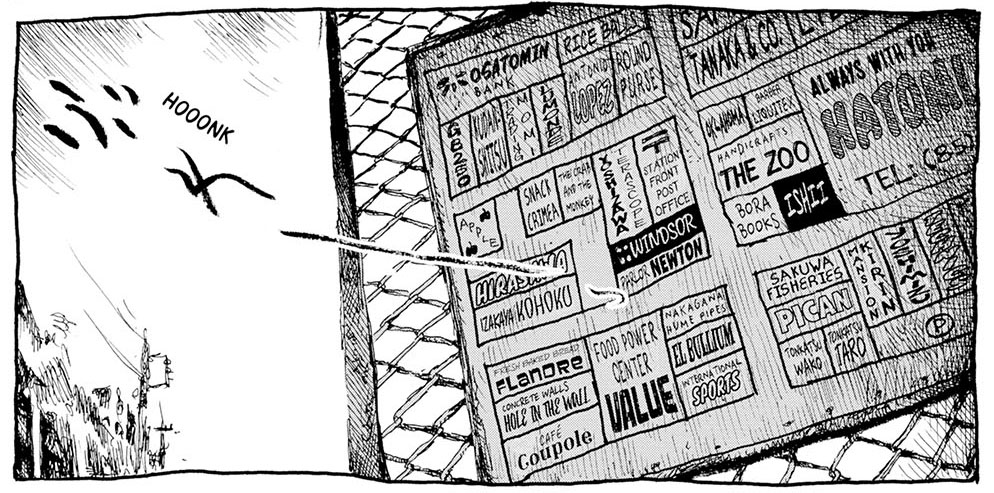
These Shisa Lions and torii gate:
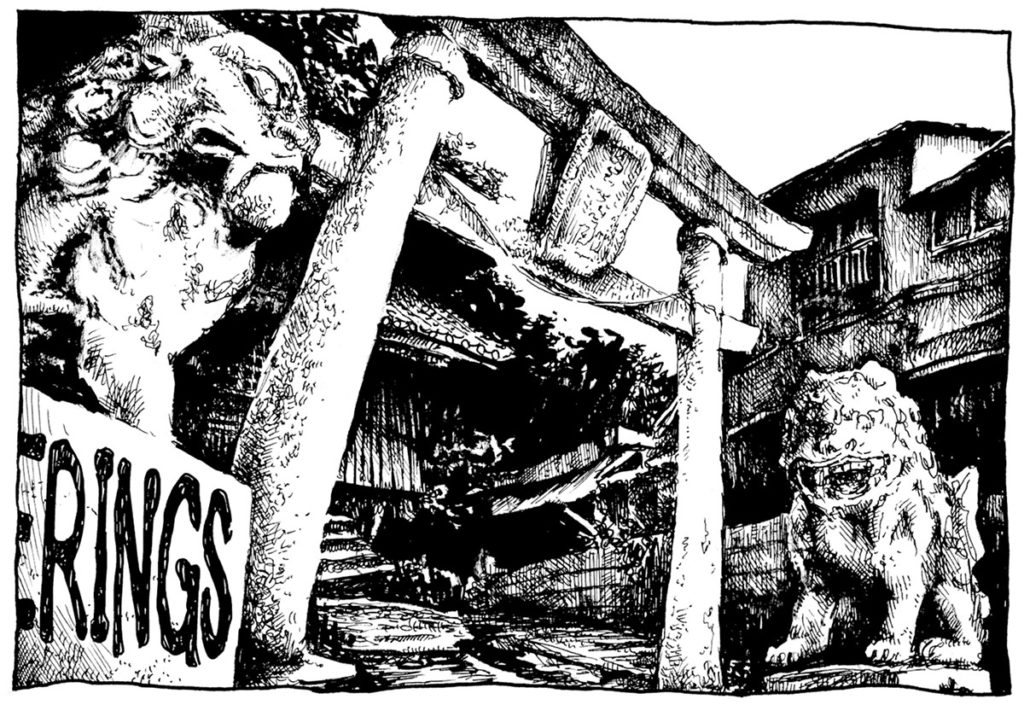
There’s so much great imagery in this book, it really is worth your time to check it out and stick with it. It’s a very different sort of manga.
41:23 THE BREAK! Please remember after this point, time-stamps are approximate.
42:00 Mangasplaining: Listen To Me! Interview with Translator Ko Ransom
Thanks to Ko Ransom for finding some time in between deadlines to do this interview with us!
You can find Ko online at https://twitter.com/kransomwastaken.
We’re looking forward to including more interviews like this in future episodes.
44:06 A quick explanation of the difference between Comitia and Comiket.
Comiket (Comic Market) is the biggest comic event in the world. It focuses primarily on doujinshi, or self-published manga, with no restrictions on content (i.e.: fan/tribute/parody works are accepted). While in recent years they have added a ‘corporate’ area for the mainstream publishers to do giveaways, for the most part, the vast majority of the exhibitors in the hall are creators selling self-published works. Comiket attracts over a million people over the 3-4 days of the event. Unlike most European or N. American comics shows, at Comiket, the doujinshi exhibitors only exhibit for one day, with the exhibitor mix switching out entirely each day. It takes place at Tokyo Big Sight, using the entirety of the massive East Hall and West Hall, as well as ever room, annex space, and outdoor space available.
[Deb]: The official Comiket website has a visitor’s guide in English for overseas visitors in case you’re curious.
In comparison, Comitia draws about 40,000 people to its events, which are held four times per year. Comitia is exclusively for doujinshi creators, and only completely original works (i.e.: No fan works, or copyrighted content which you don’t own) are allowed to be sold. Publishers do show up in a limited capacity–they have an area where manga editors will sit and you can pitch them your work to be published at their company, which is pretty cool! But the primary focus is on the hundreds of creators or groups (a group of manga creators working together is called a “circle”) selling original works. This event only takes over one of the two halls (usually). In 2021, it will only take over one of the newer adjacent buildings. So compared to Comiket, Comitia is a much smaller event, with more personal and idiosyncratic works, but still absolutely massive and overwhelming compared to any similar event in Europe or N. America. The Comitia website (Japanese) is at https://www.comitia.co.jp/.
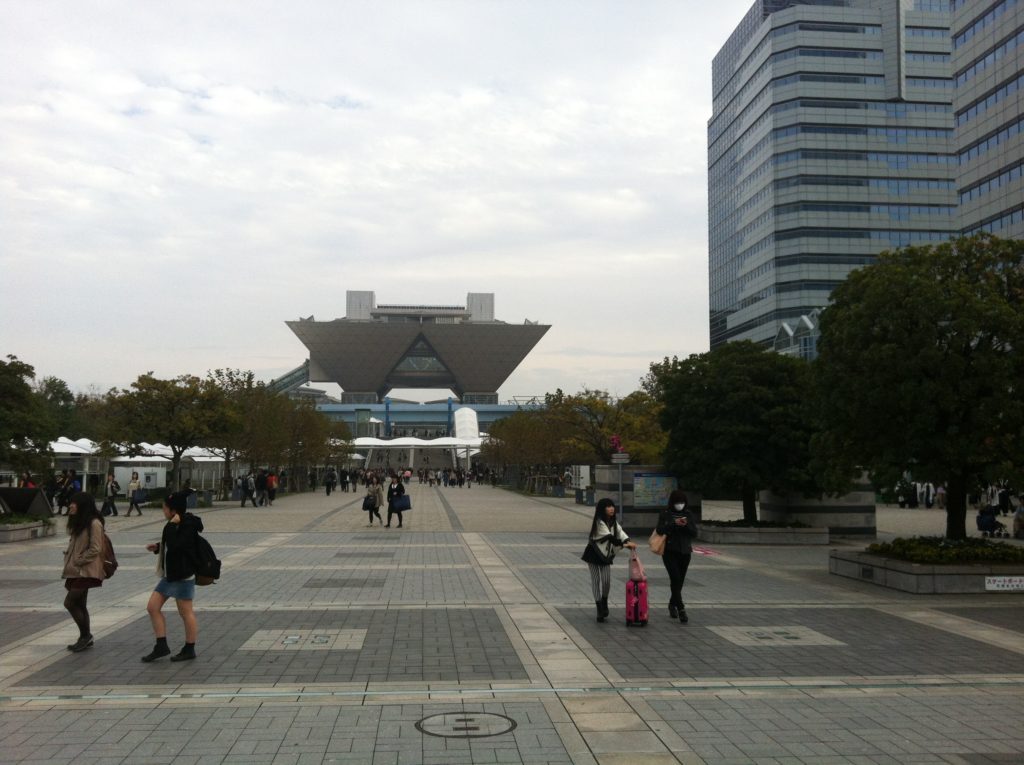
45:00 SF Kenkyu-kai – I Couldn’t find anything on this Doujinshi Circle, but I did stumble over the French-language Wikipedia for Panpanya, just now, which is STACKED with info! Panpanya doesn’t even have an English-language wikipedia entry at all, it was sort of a shock to see a really full entry in French. NICE. Maybe someone can copy this back into English? Any Wiki Editors in the audience?
https://fr.wikipedia.org/wiki/Panpanya
49:45 So I want to clarify something here, because I think it’s a common feeling these days as the hype-train is maybe bigger than it’s ever been, for everything. I generally like alt-manga, and Ko’s enthusiasm for this work (back before it was released) got me really, really excited. Flipping through some samples, and even getting the book, I was actually really thrilled. It looked almost alien, so exciting, you know? But then I read it, and we get to the sentiment expressed at the beginning of this episode–I bounced off of it. Maybe because I was so excited? Or I had different expectations? Anyway, it took reading through it and getting to a story that really worked for me, and getting onto Panpanya’s vibe, that the work ‘clicked’ for me, and then going back and reading from the beginning again I had a very different take.
It’s complicated! But I think it’s interesting to see a reader’s perceptions, reactions, and understanding of a comic can change over several re-readings.
52:30 Shout out to me– predicted that someone might bounce off of this super hard. I just thought it’d be Chip, not David and/or Deb. 😉
56:15 Here’s that promotional book cover that Ko mentions, as it appears at the back of the book!
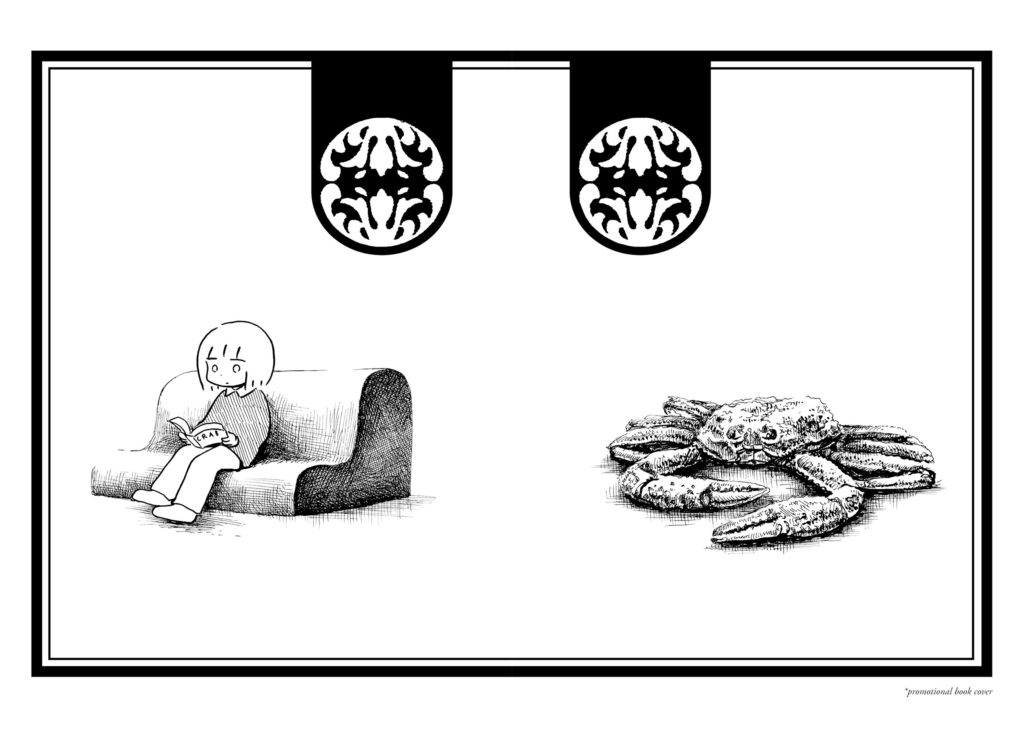
57:30 Tsuge Yoshiharu again! Thanks Ko! See the links above!
58:15 So here’s some more info on alt-manga and doujinshi being translated into English:
Ko mentions the alt-manga anthology Glaeolia, published by Glacier Bay Books. https://glacierbaybooks.com/. As I mentioned the first volume of Glaeolia is out of print, but Glaeolia 2 is available from their website.
Glacier Bay is publishing a bunch of manga from the alt/art/indy sphere in Japan, including the graphic novel Children of Mu Town by Masumura Jushichi, which was originally published as a series of doujinshi in Japan. They’ve also released Ripples by Hagiwara Rei, and a number of translated doujinshi too!
Also check out Star Fruit Books, who are publishing trade paperback manga collections including Hideshi Hino’s City of Pigs, and a wide variety of one-shot doujinshi. Check out their list at https://starfruitbooks.com/.
The Japanese art book store Popotame also released a collection of translated alternative comics, Popocomi. It’s available from the Glacier Bay website, as well as TCAF’s shop.
It’s also worth noting that these works tend to be more in the art-comix space, but independent creators that make a variety of doujin are making their works available. A good example of this is in the gay hentai doujinshi sphere. Gengoroh Tagame, the ‘daddy’ of gay manga (heh) is actually self-releasing English translations of some of his doujinshi via his website and Japanese digital doujin sites. Doujinshi means self-published work, and there’s no one look, style, and genre for doujin! http://www.tagame.org/enews/sample-page/english-books/i-got-turned-into-my-best-friends-fathers-bitch-eng/
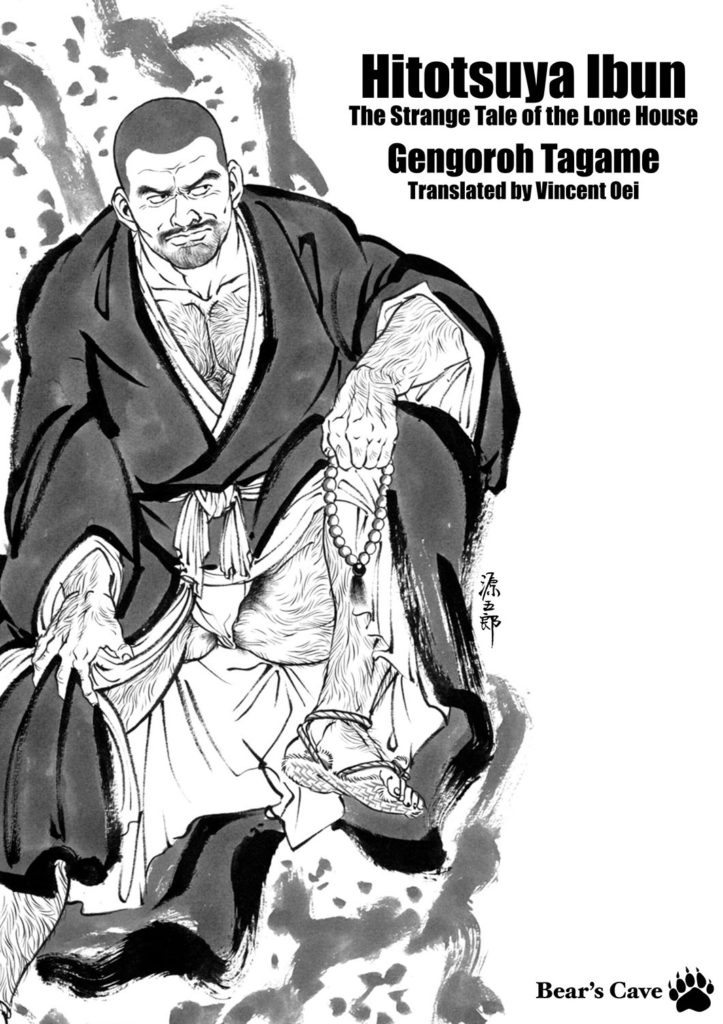
59:00 Here’s that screen shot from the Rakuen website, featuring Panpanya’s work. I love it.
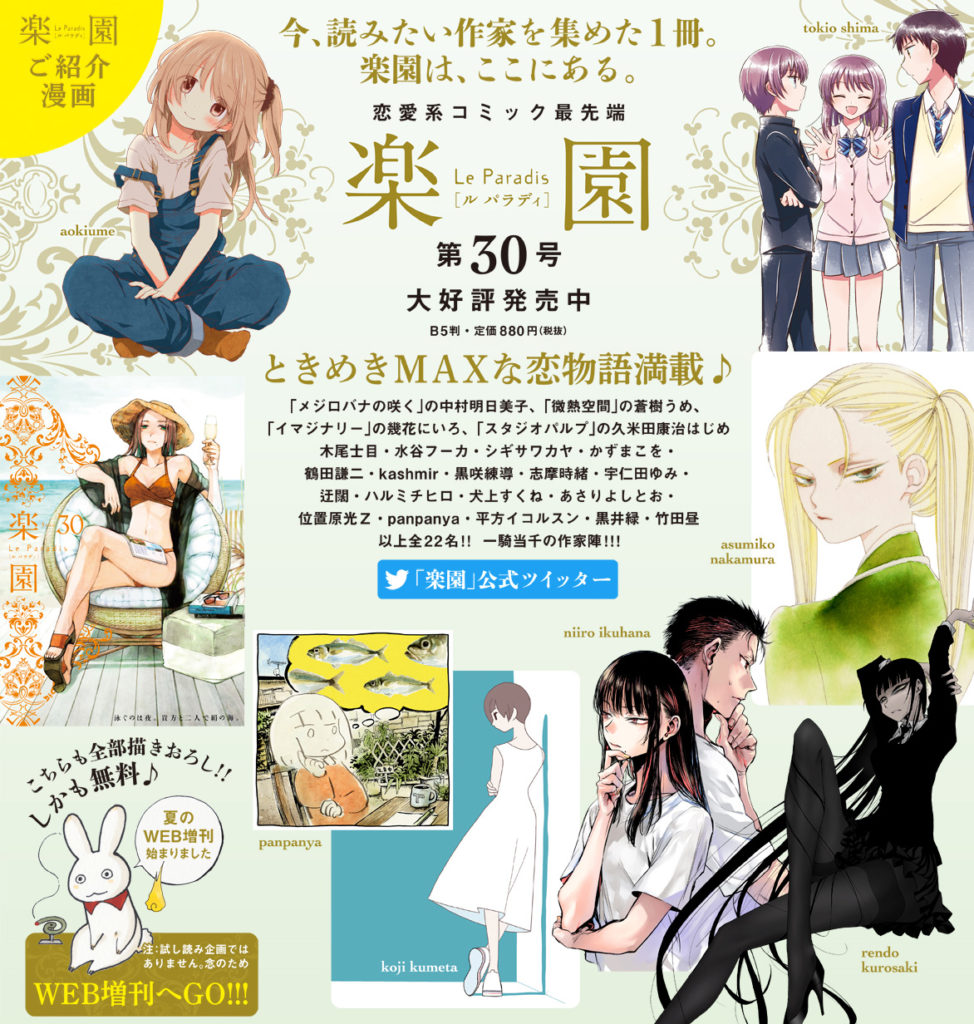
Finally, Ko was nice enough to take some photos of his original Panpanya doujinshi, all of which is probably very valuable. Changes in size, colour covers, and for Teleportation, it’s a book that’s accordion-printed and hand-bound. You really get the sense of someone who’s into the book-arts, and might be more at home in a western indie comics event than a Japanese manga doujinshi event, you know?
Very cool stuff. Thanks again, Ko!
1:04:20 It’s the SECOND BREAK!
So it’s time for the reader Q&A… and this is a big ‘ole can of worms. I think we did it justice, without resorting to stereotypes or cliches, but that’s gotta be up to y’all listening. So that said, here’s this week’s question:
“Anecdotes about mangaka working insane schedules are common, but in light of seeing Shiibashi Hiroshi’s insane schedule and reading those depressing excerpts of Kentaro Miura’s diary, I’m curious: is the profession considered especially masochistic within Japanese culture? Is it considered a lucrative career? It seems like there’s more room for artists to have success just because the industry is larger, but I’d value some insights from people who know more about both Japanese culture and their comics industry.”
Eric Schuster, Email
First up, here’s that infamous “Weekly Work Schedule of a Mangaka” by Shiibashi Hiroshi.
Secondly, here’s that excerpt from Kentaro Miura’s diary translated into English. These appeared in various volumes of Berserk. https://www.reddit.com/r/Berserk/comments/nhs1p9/miuras_diary_this_is_absolutely_heartbreaking/.
So this is a big conversation, and I don’t think it necessarily needs a ton of notation. Please forgive me.
1:14:00 Oh wow, AKIRA: Art of Wall is now available pre-order, and it’s ‘only’ $129.99, not $200+. WOW. I know that’s still a lot of money, but I’m excited to get one. The interview is really, really good.
1:15:45 We’ve talked about this before, but there are a bunch of good manga that talk about becoming a manga-ka. A Drifting Life by Yoshihiro Tatsumi, A Zoo In Winter by Jiro Taniguchi, and even Princess of Tennis by Jamie Lynn Lano, about working as an assistant on the Prince of Tennis manga. http://www.jamieism.com/work/%E2%99%A1-working-as-an-assistant-on-the-prince-of-tennis-%E2%99%A1
1:16:00 Oh man, Chip dropping the news-bombs this week.
1:22:00 Hawkeye by Matt Fraction, David Aja, and Annie Wu (among many others), collected in an omnibus that OF COURSE is completely out of print and going for $350+. It’s pretty much the direct inspiration for the upcoming Hawkeye Disney+ show. Hope that Fraction and the team get their due credit on that…
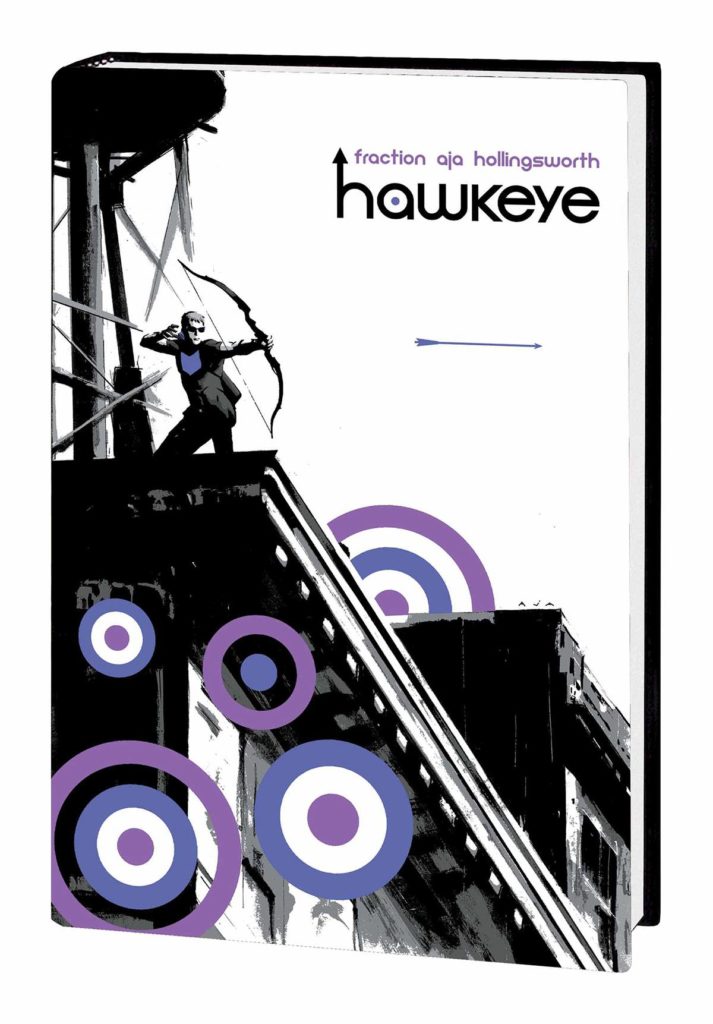
Anyway, that was a HECK of an answer…
…and a heck of an episode!
Thanks for listening. Remember to check out your local comic and manga specialty shop for all the great books. Find one near you at comicshoplocator.com. You can also check out your local library for print and digital lending options on a wide variety of manga. And as always, thanks to D.A.D.S. for their musical accompaniment this week, and we’ll see you again next time! Take care!
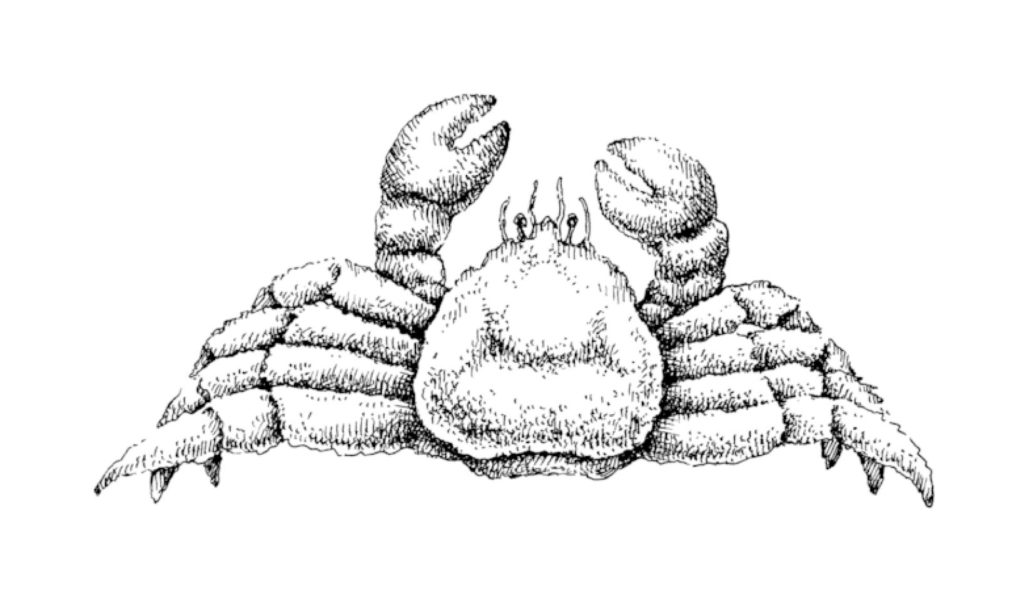
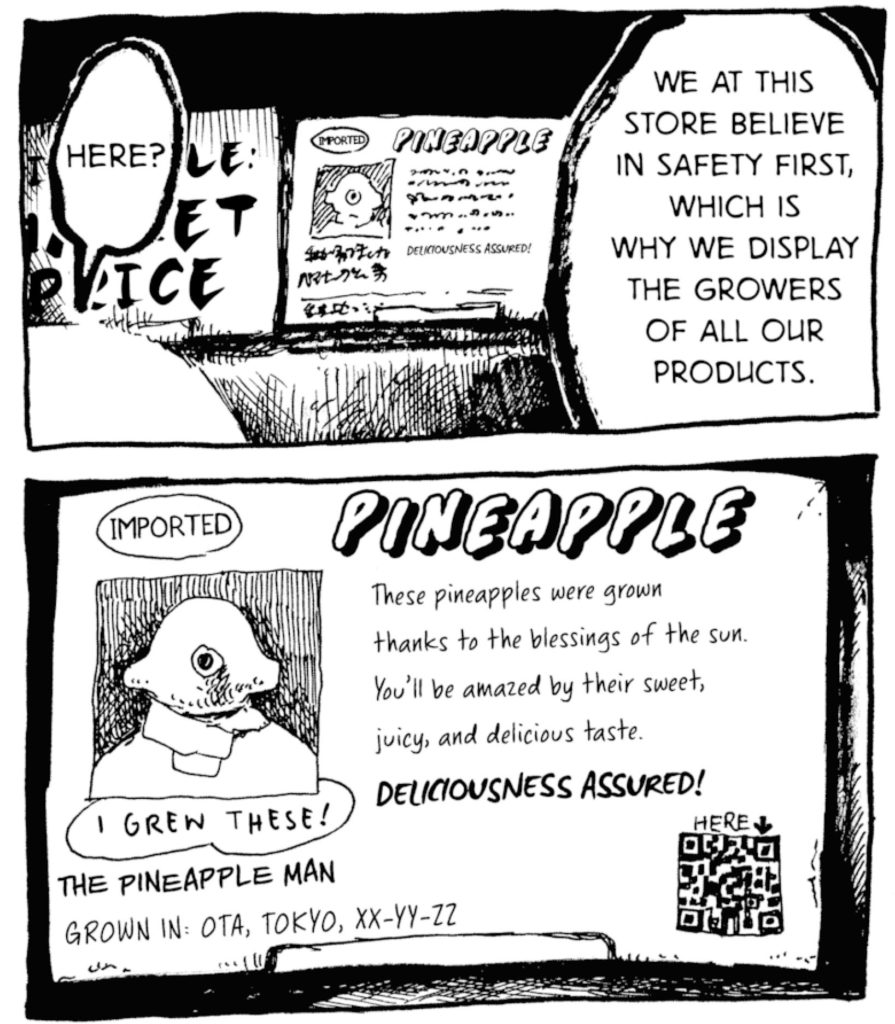
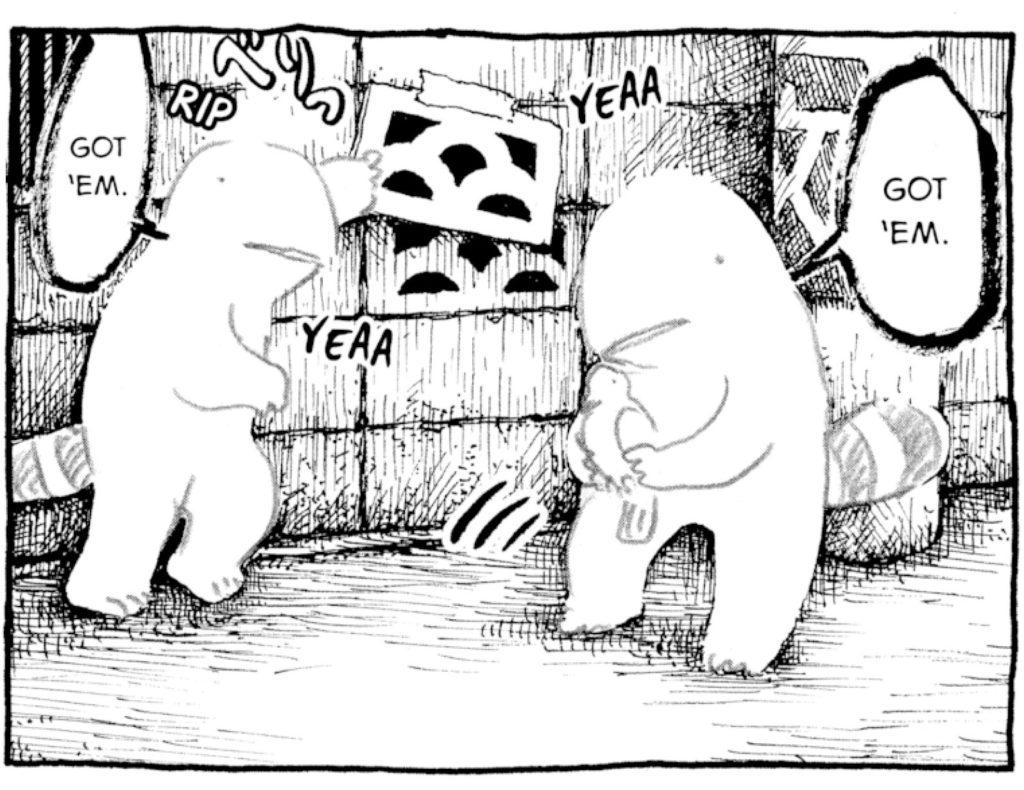
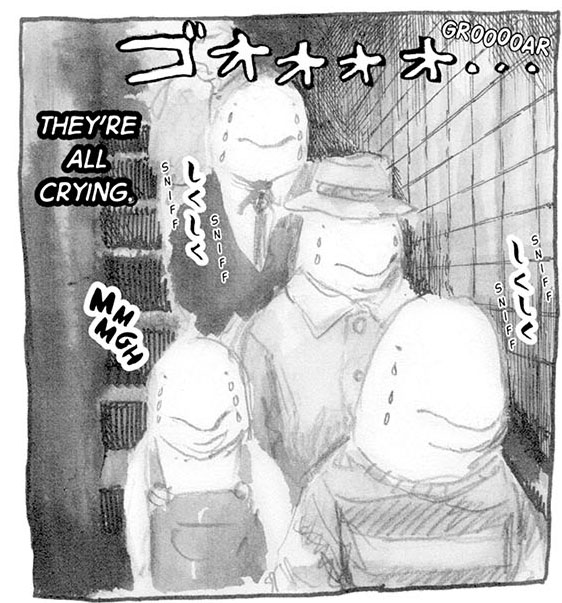

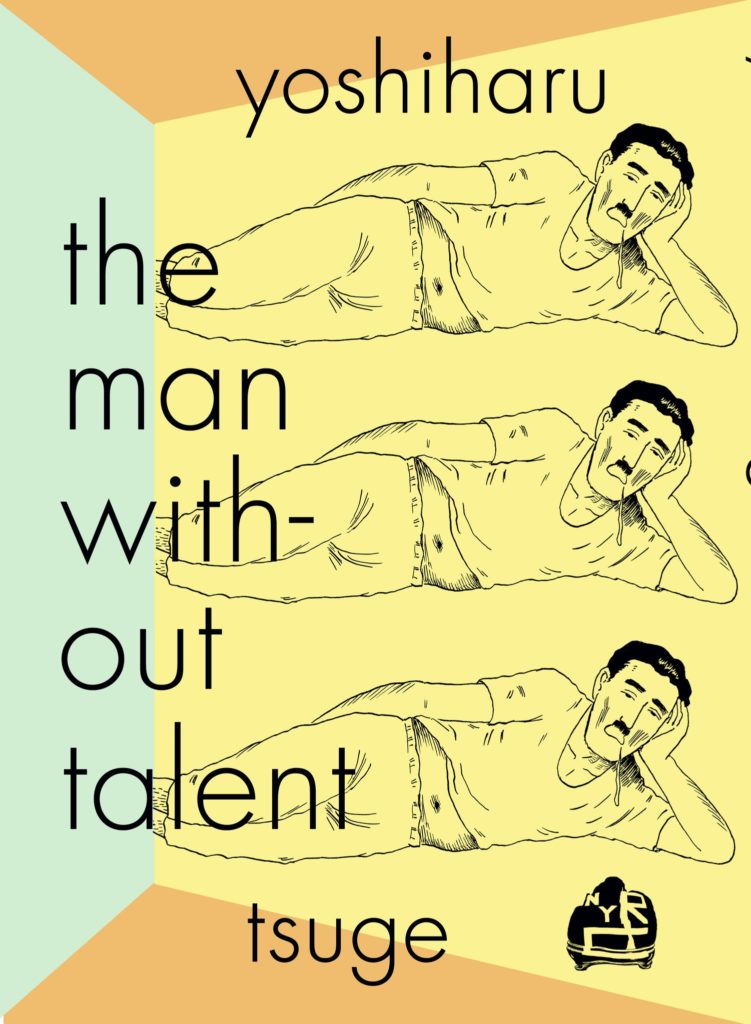
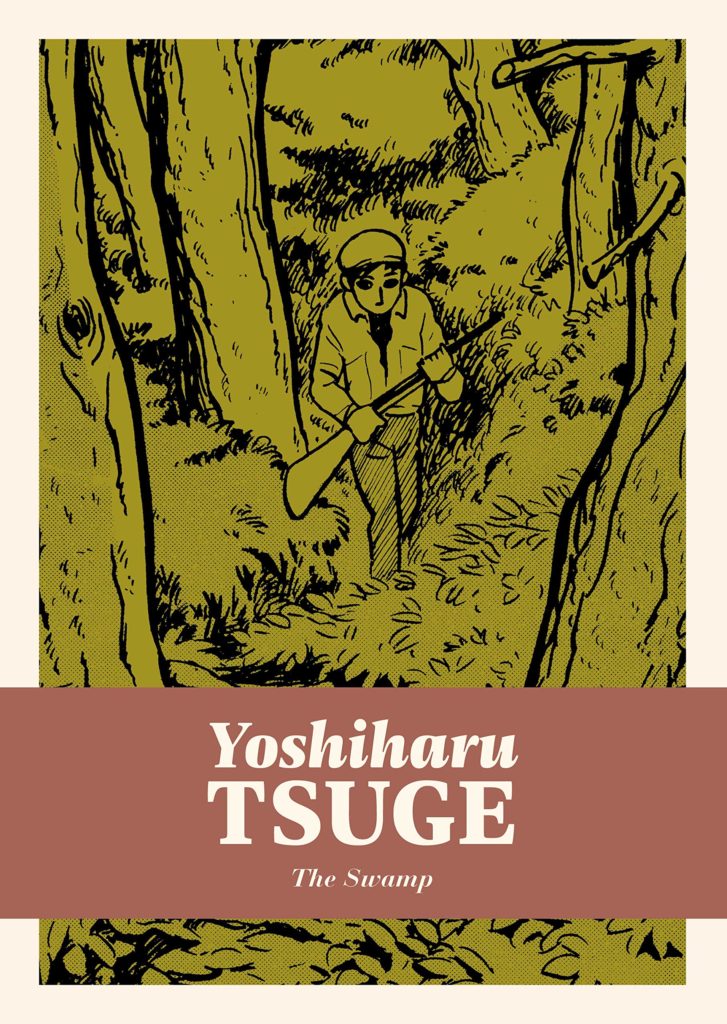
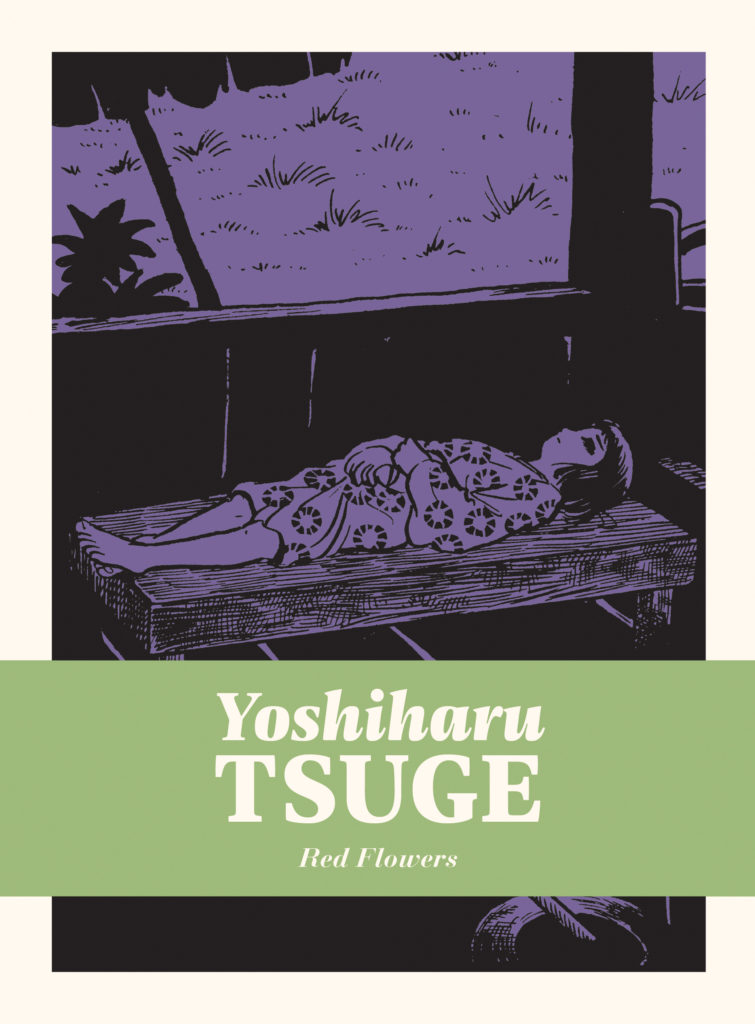
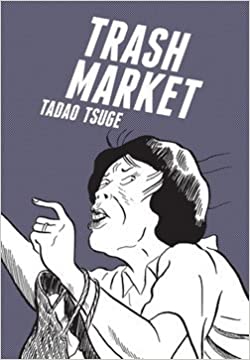
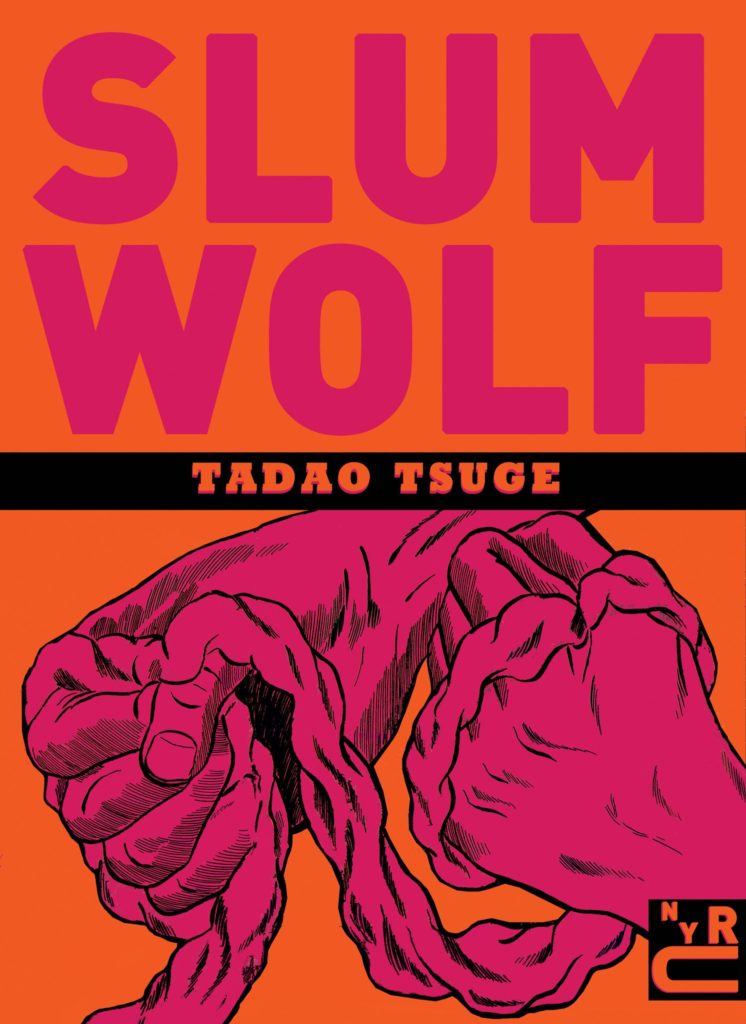
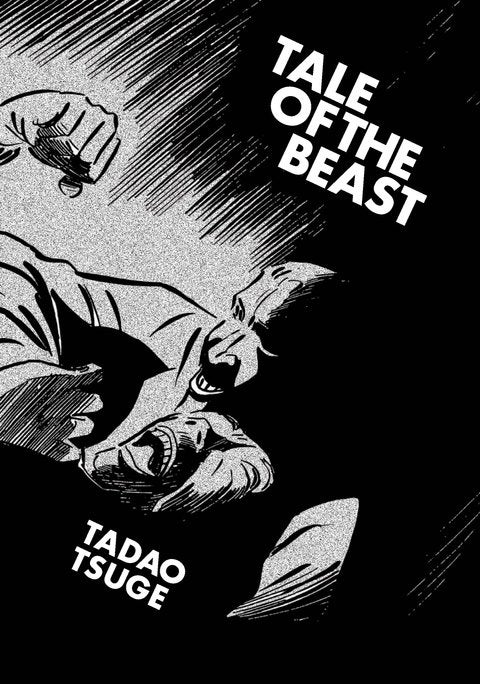
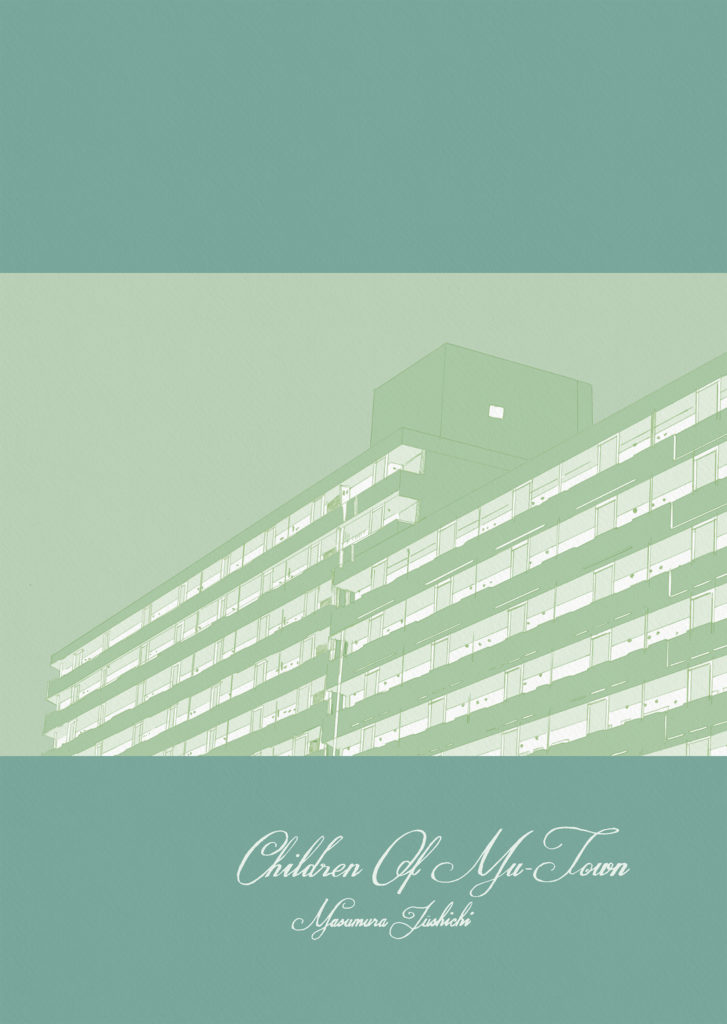
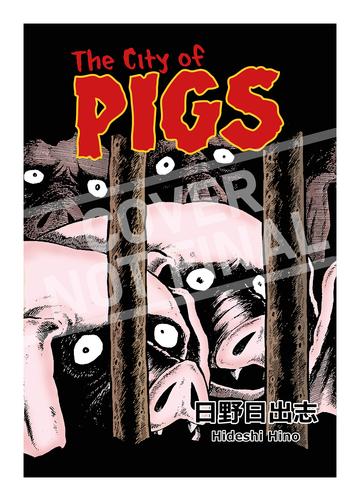
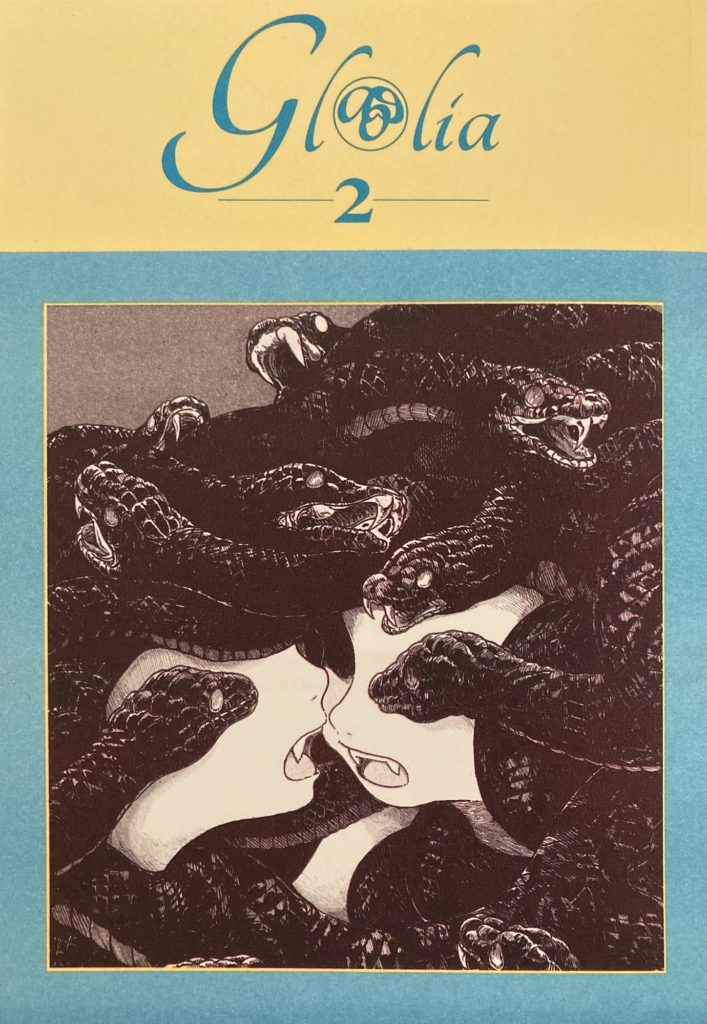
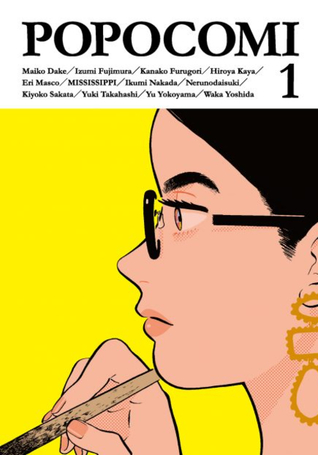
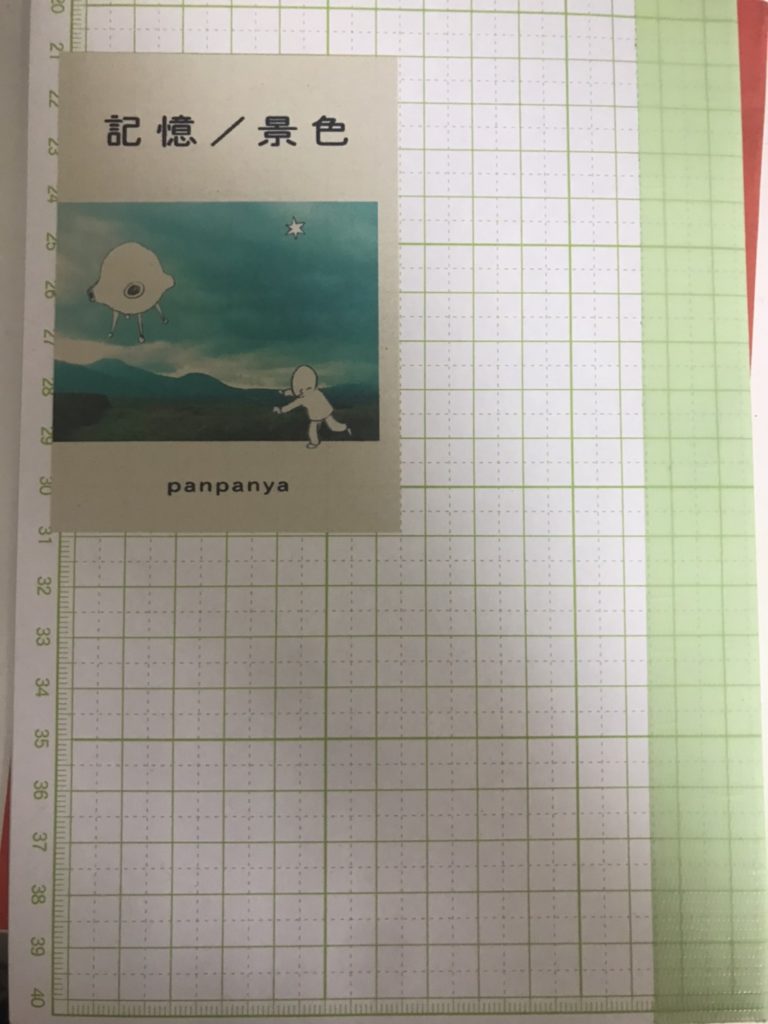
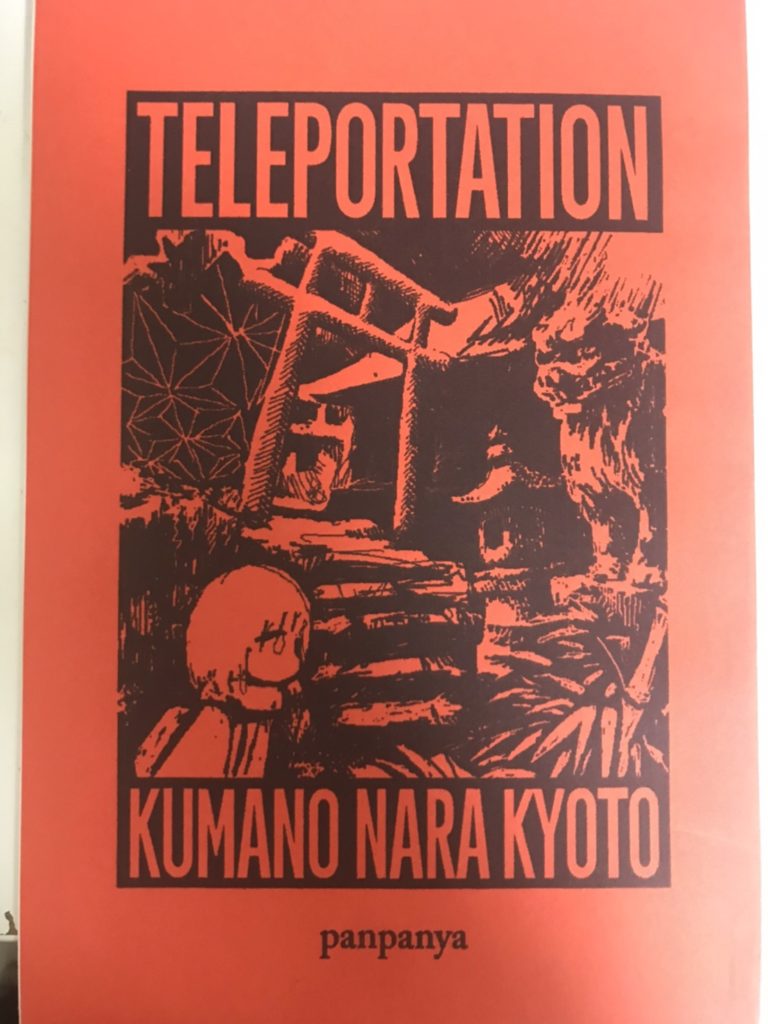
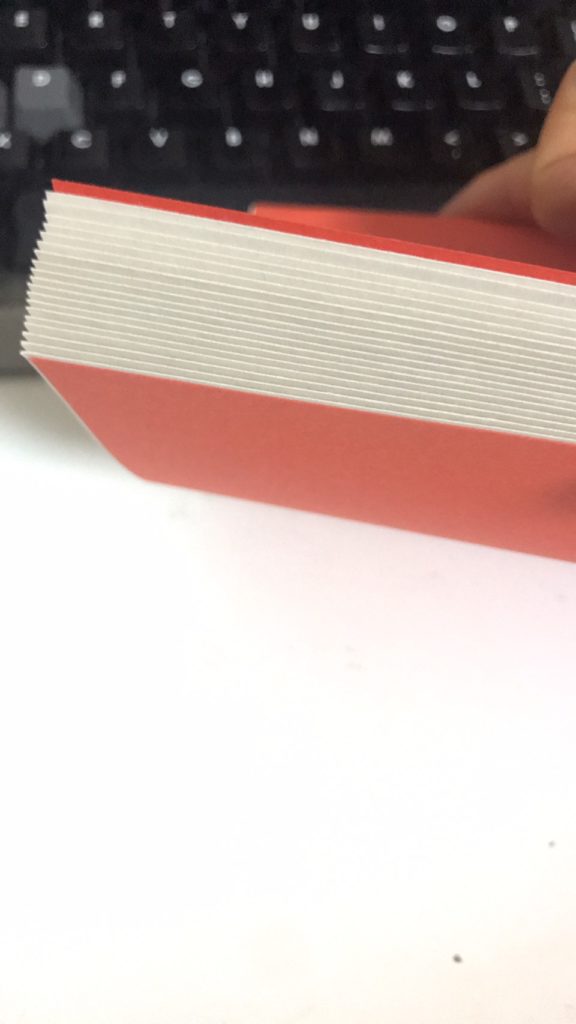
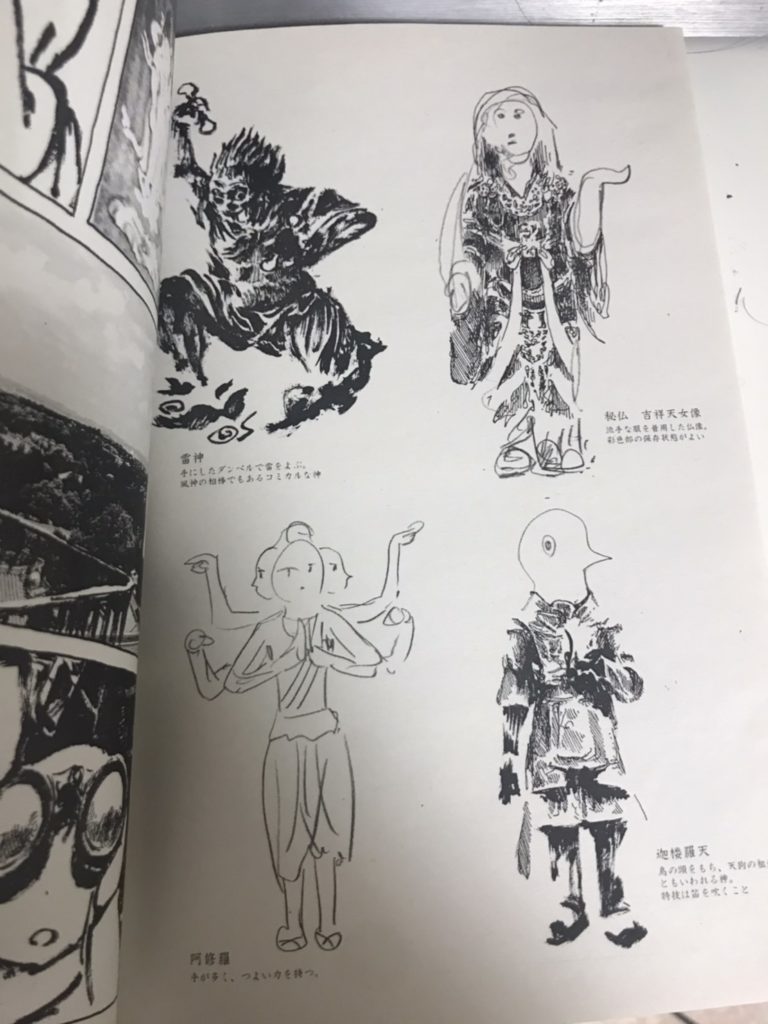
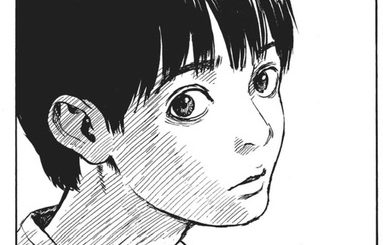
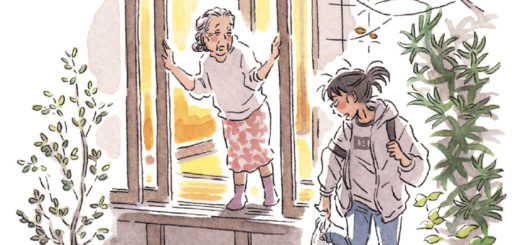
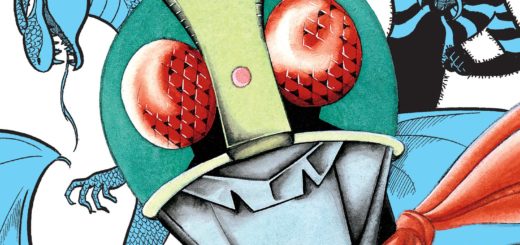
Guyabano Holiday has been pushed back for at least 1 year so far.
I think an episode on Dai Dark or Dandadan (new hype) would be interesting.
also question for the hosts:
Kingdom was recently picked up in spanish, does that help a possible english translation?
Pretty much no. Foreign editions of manga getting picked up have a very, very small effect on what gets picked up in English.
Been trying my best to keep up with my reading to stay current with this show…but I am now almost a month behind. When’s your next break coming up? 🙂
I too, like David, almost bounced from this, especially because I also thought there would be more crabs. I’ve always had a hard time getting into short story collections, because you never really get to find something to sink your teeth into. But, right when I thought I was going to bounce, it all clicked for me. This is one of the few manga I’ve read recently that really stayed with me after finishing it. Everything you said about their art style to the narrative focus, if it can be called that, of the stories all just worked really well. I too felt echoes of “Spirited Away,” which to me feels more like a 90-minute image/mood board than a narrative piece. (My feelings toward “Spirited Away,” animation quality notwithstanding, tend to wax and wane.)
Something that “Invitation from a Crab” (which is a great title–crabs are funny!) reminded me of was Marcel Proust’s “Remembrance of Things Past” because, like Proust, panpaya shows an ability to get fixated on and obsessed with something so seemingly trivial but yet explore it in a way that makes you look at it anew. The backgrounds being heavy inks that the self-insert character almost goes out of their way to ignore in an effort to focus their energy on some picayune was just masterfully done. I think the pineapple story was that for me. A pineapple is just a simple fruit, but most people don’t think about where it comes from, and that could be extended to almost anything. Her quest send her search, but the answers are still unsatisfying. I like that journey of an inquisitive mind. Is this story the manga version of Andy Warhol’s Campbell’s Soup cans?
The other story where she tries to relay what was to her a frightening experience and then utterly failing to inpart that to the listener–well, who of us hasn’t had a similar situation. All in all, it was a great read once I was able to attune myself to the vibe of the book.
Thanks for taking the time to interview Ko Ransom for this episode. Always fun to learn the process translators go through when approaching a work
Your discussion at the end, while great, was also pretty dark. I like to joke that people who visit Japan always want to write a book detailing what a great place the country is. People who come here to work would end up writing a book that was the polar opposite, if they had the energy left to write it. Work conditions in Japan are egregious, but something about the manga and anime industries are just so much more so. I may have posted this in a comment before, but I recommend “Manga Poverty” by Shuho Sato, author of “Say Hello to Black Jack,” for a good inside look at a life for moderately successful manga creator. It’s not all Porsches and caviar!
Next break in 16 episodes. 😉 But we might do a special episode… Discussing it. Thanks as always for such in depth responses!
Funny that panpanya has such a detailed french wiki page but can I find their stuff in french? Absolutely not! Gonna have to do that very expensive ‘ordering from the UK’ business if I want to read, aren’t I?
I’d been wondering about An Invitation From a Crab for some time. This episode sold me on getting a copy, what especially nailed that sale down was the mentions of Tokyo locations. Some of the Ginza buildings in the images you posted, or rather what is on the roofs of the building, are from the late 1960s and early 1970s. I’ve got to track more photos of the area from then as see what else was based on reality.
Oh fascinating, I didn’t realize they were photos of old Tokyo. That adds another layer to what the author is maybe trying to say with this book. Fascinating. Can’t wait for the next one now.
Thank you to deb for solving the mystery about Panpanya gender. At least biologically, as I have read from another source that they may identify as non binary. I felt in love with Panpanya art when traveling to Japan in late 2022 and seeing an incredible shikishi by them in a small comic book shop in Akihabara. I am Italian, and all seven tankobons of their stories have been translated into my language, with the eighth out in Japan most likely also on the way. (The ones available in English are vol.1, 3 and 7, in case you are wondering.) The fun fact is that, despite the obvious ‘indie’ allure of their work, Panpanya is published in Italy by Star Comics, the biggest and most mainstream manga publisher in the country.
“biological gender” isn’t a thing